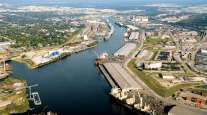Drayage Truckers Ask Terminals to Speed Turn Times, Aid Drivers
This story appears in the Oct. 6 print edition of Transport Topics.
BALTIMORE — Port truckers took their case for improved terminal productivity and greater cooperation with chassis owners to a Federal Maritime Commission forum here at one of the nation’s largest ports.
Motor carriers on Oct. 1 outlined the severe problems created at some ports when drivers can’t move through terminals efficiently. There were multiple calls for longer gate hours and chassis pools.
“We are stuck in the middle” as drayage carriers are losing more drivers than other motor carriers, said Wayne Gaumer, president of Lightning Transportation, based Hagerstown, Maryland.
“The time that drivers spend delayed at the port is a major issue,” he said. “If conditions don’t improve, drivers will leave the industry.”
The forum was one of three convened by FMC to evaluate port congestion. One was held Sept. 15 in California and the other is slated for New Orleans on Nov. 3.
Without naming a specific ocean carrier or terminal, Gaumer said a vessel arrived three days late, causing some of his workers to get no income on two days. He also noted that trip times through terminals for a single load can range from one to four hours, depending on the port.
Gerry Coyle, vice president of Schuylkill Haven, Pennsylvania-based Evans Network of Cos., also was among those calling for longer hours, since some port gates are open less than 40 hours a week.
He called for new steps to dramatize congestion, with publicly available metrics on port/terminal performance to put a spotlight on the problems.
His horror story was an Evans driver who spent 13 hours at an unidentified terminal trying to get a load. The target, speakers suggested, is one hour or less.
Shirley Roebuck, general manager of Gilco Trucking Co. in Portsmouth, Virginia, chronicled the consequences of delays. Congestion often wastes five hours of Gilco drivers’ time without completing a single trip.
That’s far below the six trips a day that drivers need to live comfortably, she said. Some are getting as two trips on a single day.
David Manning, who chairs the truckers’ North American Chassis Pool Cooperative, said there was a need for “free competition” for the equipment.
“Truckers are prevented from picking the chassis provider, yet they are paying the bill. The [trucker] has had no chance to dictate prices and terms for using chassis,” said Manning, who is president of drayage carrier TCW, based in Nashville, Tennessee. He is also a vice chairman of American Trucking Associations.
The problem, Manning said, is that ocean carriers can specify chassis usage through agreements with leasing companies, who bought chassis from them at inflated prices.
Chassis lessors had their own litany of inefficiency, as exemplified by Direct ChassisLink, or DCLI, which advocated more use of pools.
CEO William Shea offered an example from a Los Angeles terminal. DCLI needed to move in 300 chassis, while rival operator FlexiVan had to move out 275 units from the same terminal.
Because there was no cooperative pool, a total of 575 moves had to be made. However, if there had been a pool in place, DCLI could have used the 275 FlexiVan units, and then only moved in 25 additional units to fill their quota of 300.
At the same time, port leaders made it clear that congestion is a worldwide issue that extends beyond the Mid-Atlantic region that the focus of the Oct. 1 meeting.
“Congestion issues are all over the world,” said John Reinhart, executive director at the Port of Virginia. “Here in North America, we did not invest heavily enough” in infrastructure, such as cranes.
He noted that his port has grown 6.5% annually for five years without adding land, and have experienced record volumes in six of the past nine months. Virginia also is handicapped by the lack of federal cargo inspectors, whose workforce is the same size as in 2008.
Reinhart and others made a point of praising union officials for efforts to boost productivity. At his port, the workforce has grown by 11%, far faster than cargo growth.



